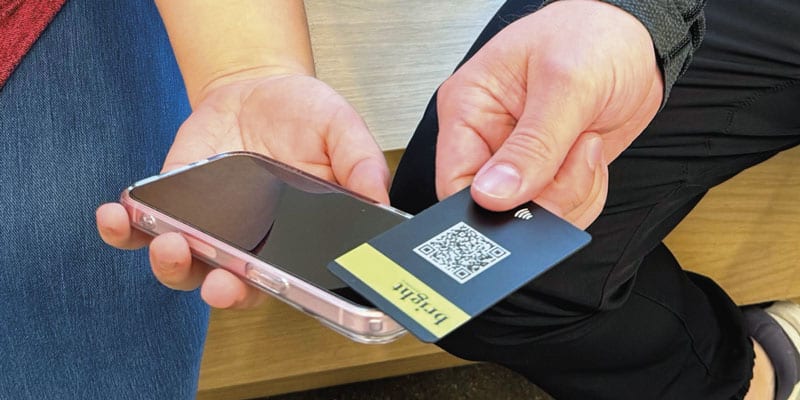Dr. Steven Semaan describes a new technology for referrals that makes it fun and easy to steer patients to your door.

Dr. Steven Semaan talks about the importance of referrals and a new technology that promises to change and improve the process.
Referrals are one of the most powerful ways that orthodontic practices connect with new patients and expand their reach. With social media, the internet, and word of mouth as modern ways for patients to find an orthodontist, it is important that your referring GP has a technology-based and easy way to steer patients to your door.
The challenge that orthodontists face with traditional paper referrals is that they are extremely ineffective. Once the patient leaves the office, the paper referral can be lost, crumbled, thrown away, and basically ignored. Both the GP and orthodontist give up all control after handing the patient that piece of paper. The orthodontist has no idea when a patient is referred, who the patient is, if they called, or even plan to. On the business side of practice development, paper referrals can’t track how active their referral network actually is, or how many patients are told to call but never take action to make an appointment. Besides the orthodontist, the paper referral doesn’t do the GP any good either. It doesn’t provide any follow-up to find out if the patient ever got to the orthodontist. That’s an important aspect if the GP is waiting for the orthodontic consult to continue a treatment plan.
Paper referrals provide no information to the patient other than the orthodontist’s name. Patients obviously would want to have more information on this specialist with whom they will spend the next few years. They must do an internet search trying to find the information on this new doctor (Dr. What’s His Name — I can’t find the paper the GP gave me!). It’s just another hassle in their already busy lives.
Technology has provided some improvements with software that links orthodontists with their GPs. Software is better than paper, but then the GP must be amenable to learning whatever software the specialist uses — and considering that each orthodontist may have their own preferred software — this is actually a pretty big request from a specialist.
Since May 2023, I have been using a new system called Bright Referral. With no need to download or buy a new software system, Bright Referral replaces the paper referral with a smart card that the patient taps on their phone. With this tap, up pops a custom experience exactly right for the patient being referred from that GP to me. The patient can learn about our practice, see our locations, schedule an appointment, save contact information, call or text, understand insurance policies, and even ask for follow-up. They don’t have to plod through the internet to do research on their own (and possibly find another orthodontist during their search).
Plus, as the doctor receiving the referral, we see all of this happening in real time and can plan, prep, and follow-up with this new patient immediately.
I love being an early tech adopter, and referral tracking is a problem I knew we had, but couldn’t solve. Setup of Bright Referral took 5 minutes. All I had to do was log-in on the website and enter my info. Since starting, smaller referrers are referring more, because it is so easy and, frankly, cool to use. The system keeps metrics and charts on how effective my referral network is, so over time, so I can make decisions, plan, and update my processes as needed. I’m strengthening relationships with referring offices based on data and insight, and getting referrals in the door more consistently and more quickly. I have had 94 referrals in the past 5 months, and this with only a handful of referral sources rolled out.

From the GP perspective
Dr. Roy Krengel (@krengeldental) is a general dentist in the Minneapolis metro area who has been using Bright Referral cards since January 2023. He is usually skeptical when a specialist approaches him with a new technology because it means retraining his staff or learning a new software. He finds it too much work for his staff to change things up for just one specialist office. He describes, “After the demonstration, I was floored. We really didn’t have to change anything at all. In fact, it made the referral process easier, faster, and cooler. Something that patients loved. Instead of finding a pen and scrawling notes on the referral slip, I tap the Bright Card to the patient’s phone and use the voice memo to talk through any notes.”
Tap and talk
The voice memo is a new and very useful feature in the system. The GP can share a voice memo note by just tapping on the record button and talking about what the patient may need. The patient then submits, and the orthodontist receives the voice memo within the system so they can hit play any time they want.
Depending on the size of the practice, a small GP office can refer to 20 different specialist offices, and orthodontists can have between 20 and 80 GPs referring to them. That’s a lot to keep track of. Studies consistently cite between 30% and 55% of referrals never follow-up with the next doctor. With that amount of influence on your patient care and practice growth, referrals need to be encouraged, followed up on, tracked, and even analyzed to fulfill their fullest potential. Bright Referral makes all that easy and considers the needs of the specialist, GP, and patients in providing a service that at this time, no other referral methods are able to achieve.
Connecting with patients through community involvement is another way to increase referrals. Read “Gone are the days of ‘spray and pray’ marketing for new patients,” by JoAn Majors, here: https://orthopracticeus.com/practice-management/gone-are-the-days-of-spray-and-pray-marketing-for-new-patients/
Stay Relevant With Orthodontic Practice US
Join our email list for CE courses and webinars, articles and mores


